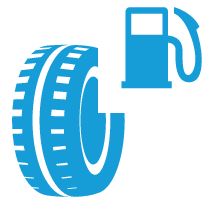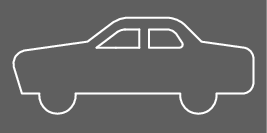 | gram CO₂/km |
 | litre/100 km |
 | urban driving |
 | extra-urban driving |
 | combined driving |
 | Tyre rating for rolling resistance according to EU directive no. 1222/2009 |
 | manual gearbox |
 | Automatic gearbox |
Note
Note
V40
|  |  |  |  | ||||
|---|---|---|---|---|---|---|---|---|
 |  |  |  |  |  | |||
| T2 (B4204T17) |  | A | 183 | 7.9 | 110 | 4.7 | 137 | 5.9 |
| B | 186 | 8.0 | 112 | 4.8 | 139 | 6.0 | ||
| C | 189 | 8.1 | 115 | 4.9 | 142 | 6.1 | ||
| E | 193 | 8.3 | 117 | 5.0 | 145 | 6.2 | ||
| T2 (B4154T3) |  | A | 162 | 7.0 | 110 | 4.7 | 129 | 5.6 |
| B | 165 | 7.1 | 112 | 4.8 | 131 | 5.6 | ||
| C | 168 | 7.2 | 114 | 4.9 | 133 | 5.7 | ||
| E | 171 | 7.4 | 116 | 5.0 | 136 | 5.9 | ||
| T3 (B4204T33) |  | A | 186 | 8.0 | 112 | 4.8 | 139 | 6.0 |
| B | 187 | 8.1 | 114 | 4.9 | 141 | 6.1 | ||
| C | 189 | 8.1 | 116 | 5.0 | 143 | 6.1 | ||
| E | 190 | 8.2 | 118 | 5.1 | 145 | 6.2 | ||
| T3 (B4154T2) |  | A | 162 | 7.0 | 115 | 4.9 | 132 | 5.7 |
| B | 164 | 7.0 | 117 | 5.0 | 134 | 5.8 | ||
| C | 165 | 7.1 | 119 | 5.1 | 136 | 5.9 | ||
| E | 167 | 7.2 | 121 | 5.2 | 138 | 6.0 | ||
| D2 (D4204T13) |  | A | - | - | - | - | - | - |
| B | - | - | - | - | - | - | ||
| C | - | - | - | - | - | - | ||
| E | - | - | - | - | - | - | ||
| D2 (D4204T13) |  | A | - | - | - | - | - | - |
| B | - | - | - | - | - | - | ||
| C | - | - | - | - | - | - | ||
| E | - | - | - | - | - | - | ||
| D3 (D4204T16) |  | A | - | - | - | - | - | - |
| B | - | - | - | - | - | - | ||
| C | - | - | - | - | - | - | ||
| E | - | - | - | - | - | - | ||
| D3 (D4204T16) |  | A | - | - | - | - | - | - |
| B | - | - | - | - | - | - | ||
| C | - | - | - | - | - | - | ||
| E | - | - | - | - | - | - | ||
Fuel consumption
Fuel consumption and emission values in the table above are based on specific EU driving cycles (see below), that apply to cars with kerb weight in the basic version and without extra equipment. The car's weight may increase depending on equipment. This, as well as how heavily the car is loaded, increases fuel consumption and carbon dioxide emissions.
There are several reasons for increased fuel consumption compared with the table's values. Examples of this are:
- If the car is equipped with extra equipment that affects the car's weight.
- The driver's driving style.
- If the customer chooses wheels other than those fitted as standard on the model's basic version then rolling resistance may increase.
- High speed results in increased wind resistance.
- Fuel quality, road and traffic conditions, weather and the condition of the car.
A combination of the above-mentioned examples can result in significantly increased consumption.
Large deviations in fuel consumption may arise in a comparison with the EU driving cycles (see below) which are used in the certification of the car and on which the consumption figures in the table are based. For further information, please refer to the regulations referred to.
Consumption is higher and power output lower for fuel with an octane rating of 91 RON.
Note
EU driving cycles
Official fuel consumption figures are based on two standardised driving cycles in a laboratory environment ("EU driving cycles") all in accordance with EU Regulation no 692/2008, 715/2007 (Euro 5 / Euro 6), 2017/1151 and 2017/1153. Since the driving cycles are also used for quality control, there are significant requirements for repeatability of the tests. For this reason the tests are carried out under close scrutiny and only with the car's basic functions (e.g. air conditioning, radio, etc. switched off). As a consequence of this the results from the official figures are not obviously representative of what the customer sees during actual usage.
The regulations cover the driving cycles for "Urban driving" and "Extra-urban driving":
- Urban driving – the measurement starts with cold starting the engine. The driving is simulated.
- Extra-urban driving – the car is accelerated and braked at speeds between 0–120 km/h (0-75 mph). The driving is simulated.
Cars with manual gearbox are started in 2nd gear.
The official value for combined driving, which is reported in the table, is a combination of the results from the "Urban driving" and "Extra-urban driving" driving cycles, in accordance with legal requirements.
The exhaust gases are collected in order to extrapolate the carbon dioxide emissions (CO₂ emissions) during the two driving cycles. These are then analysed and give the value for CO₂ emissions.
